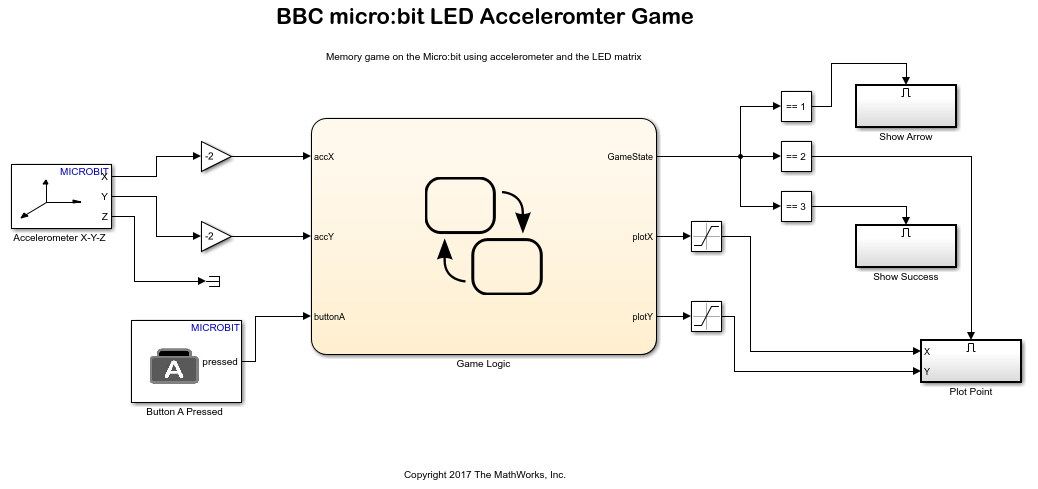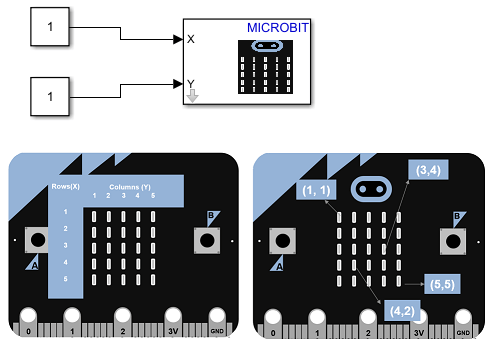Use Tilt Control on BBC micro:bit to Reach to a Target LED
This example shows you how to use a Simulink® model to build a simple game that uses tilt control on BBC micro:bit to reach to a target LED on the LED matrix, and see a happy face LED image upon success.
Introduction
The Simulink® Coder Support Package for BBC micro:bit board provides blocks that represent the 5x5 LED matrix and the accelerometer sensor. In this example, you will learn about a Simulink model that is designed to be a game for the BBC micro:bit board. This Simulink model performs the following functions:
Starts the game when you press a button on the BBC micro:bit board, and flashes a random LED that is the "target" of the game
Reads the current accelerometer data (XY data) of the board and lights up the corresponding LED on the LED matrix. The position of this active LED changes with the tilt of the board in all directions.
Displays a happy face LED image if the active LED matches the target LED (that is, accelerometer data and its LED mapping matches the target LED)
Prerequisites
If you are new to Simulink, watch the Simulink Quick Start and Getting Started with Stateflow videos.
If you are new to Simulink Coder, visit the Simulink Coder product page for an overview and tutorials.
We also recommend completing Getting Started with Simulink Coder Support Package for BBC micro:bit.
Required Hardware
To run this example, you will need the following hardware:
BBC micro:bit board
USB type A to Micro-B cable (The one given with the BBC micro:bit board)
Task 1 - Open the Model and Play the Game
1. Open the bbcmicrobit_accelLED_game model.

2. In the Hardware tab, click Build, Deploy & Start.
After you have successfully deployed the Simulink model on BBC micro:bit board, you can start playing the game:
1. Press button A on the BBC micro:bit board. A random LED lights up for 1 second on the 5x5 LED matrix. This is the initial reference point (target).
2. Another LED lights up based on the current position of the board.
3. Tilt the board in all directions. The position of the LED also changes based on the current position of the board.
4. When the LED matches the initial reference LED, a happy face LED image is displayed to indicate success.
Task 2 - Understand How the Simulink Model Works
In the Simulink model, Game Logic is a stateflow, which has three inputs and three outputs:
buttonA is the input that triggers the game when you press Button A on the BBC Micro:bit board
accX and accY are the inputs that correspond to data from the Accelerometer X-Y-Z block, and they represent the current position of the board
plotX and plotY are the outputs from the logic, and they light up the corresponding LED based on the XY values
GameState is the output from the logic, and it represents the three output states of the game, based on the execution of logic in the Game Logic stateflow
To understand the logic, open the Game Logic stateflow diagram in the Simulink model.

The Game Logic stateflow contains states (modes of operation) and the logic for switching between the states.
1. In the first state (Wait_For_Button_Press), the stateflow waits for the player to press the button which is monitored with the Button A pressed block. Once the player presses the button, the second state is activated.
2. In the second state (Show_LED_Position), a random point is generated and stored in memory. This point is sent to the PlotXY block outside the stateflow with the help of plotX and plotY outputs. Then, after a wait time of 1 second, the third state becomes active.
3. In the third state (Game_Run), the accelerometer sensor values are read. These values translate to activation of an LED using the PlotXY block. The XY position is also compared with the one stored in memory. As long as the positions are not the same, the same state is active. (The player continues to tilt the board and observe the changing LED.)
Once the player reaches the initial reference (target LED), the fourth state is activated.
4. In the fourth state (Game_End), the Happy face LED image is shown for two seconds. State 1 is then re-activated. This completes one round, and the game can be continued.
The following topics provide a description of the logic used in this Simulink model.
Showing a Single Point on the LED Matrix Using LED/PlotXY Block
The LED matrix can be split into rows and columns. Any LED can be accessed by using its row number and column number. The LED/PlotXY block can light a single LED. For example, to light up the LED in the first row and first column, input 1 to the X port and 1 to the Y port.

Reading the Accelerometer Data and Mapping the Tilt of the Board to the LED Matrix
The accelerometer on the BBC micro:bit board measures the acceleration of the board along the X, Y, and Z directions. It can also be used to find the angle at which the board is tilted.
To understand the relation between accelerometer data and tilt angle, open this bbcmicrobit_accel_scope model and perform Monitor and Tune action (connect the hardware, go to the Hardware tab in the model, and click Monitor & Tune).
While performing the Monitor and Tune action, tilt the board slowly in X and Y directions and notice the values change from -1 to 1. Do not shake the board while doing this because it results in high acceleration.

When the BBC micro:bit board is tilted, the LED position has to shift proportionally to the tilt angle. This involves reading the accelerometer XY data and setting the LED position using PlotXY block.
Because the accelerometer output is from -1 to 1, and the LED matrix accepts values from 1 to 5, a modification of values needs to be done:
1. Multiply the accelerometer values by '2.5'. The new range will be -2.5 to 2.5.
2. Add 3.5 to the above step. The new range will be 1 to 6. The maximum LED matrix index is 5, so a value of 6 is addressed by using the saturation blocks outside the stateflow.
The range is calculated as: range = (accX * 2.5 + 3.5), where accX is the input from the Accelerometer block.
If the board is tilted left, the active LED moves left. If the board is tilted right, the LED moves right. Similarly, the LED shifts position forward and backward based on the forward or backward tilt. With this control, you can navigate to any desired LED position.
Using Enabled Subsystems
The output from the Game Logic stateflow is connected to three Enabled Subsystems - Show Arrow, Show Success, and Plot Point. Each of these Enabled Subsystems contains an Enable block that is dependent on the GameState output from the stateflow.
Show Arrow - Contains a PointLeft LED image block and a 5x5LEDMatrix block. This subsystem is responsible for showing an arrow pointing to the Button A on the board, when you are about to start the game.
Plot Point - Contains the LED/PlotXY block. This subsystem is responsible for lighting up a particular LED based on X and Y values, when you are playing the game.
Show Success - Contains the Happy face block and a 5x5LEDMatrix block. This subsystem is responsible for showing the happy face LED image if you win the game.
At any time, only one Enabled Subsystem is enabled by the Game Logic stateflow. The GameState output is a single synchronization output, which is updated in every state inside the stateflow. Depending on the state of the stateflow, the required block can be activated using a Compare to Constant block. If the GameState is equal to the constant in the Compare to Constant block, then that particular Enabled Subsystem will be activated.
Using Gain Blocks at the Input
To avoid forcing players to tilt the board at a large angle to reach the outer points in the LED matrix, a Gain block is added before each of the accelerometer output values reaches the Game Logic stateflow input. The gain is set to 2, which multiplies the accelerometer values by 2. With this modification, the tilt angle required to reach the extremes is reduced by half.
The new range can be calculated as: New range = ((accX * 2) * 2.5 + 3.5)
The new range will be from [-1.5 to 8.5]. It can be noticed from the model that the gain is set to -2. This reverses the direction of movement of LED with respect to the tilt. Try using 2 instead of -2, and notice the difference.
Using Saturation Blocks at the Output
The range of accelerometer values are shifted from 1 to 6, to -1.5 to 8.5 using Gain blocks. However, this is out of range for the LED/PlotXY block. To solve this, a Saturation block is used, and the limits are set to 1 and 5. This means that if a X or Y value is greater than 5, the output will be 5, and if the values are less than 1, the output will be 1.
Other Things to Try
Create a game to determine the number of clicks on a button on the BBC micro:bit board.
Tip: You can design the game to be played by two people. See the bbcmicrobit_two_button_game model.